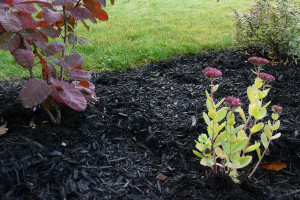Mulch can be one of the gardener’s most valuable tools and an essential component of low-maintenance landscapes. 
Earlier this week we posted an article covering frequently asked questions about mulch. If you found it helpful, we’d like to share with you another article that also provides some great information, tips and answers for problem scenarios.
Mulch reduces the amount of water lost through evaporation by shielding the soil from the sun’s drying rays. It keeps the soil cooler during the summer and acts as an insulator through the cold winter months lessening the effects of fluctuating temperatures on plant roots which in turn decreases their susceptibility to frost heaving.
Did you know that mulch applied too thickly can cause problems? Water may be unable to penetrate the mulch and reach the soil and plants fail to receive adequate moisture. It can also lead to root and stem rot problems in plants. It’s best to place mulch 2-3″ deep and replace it more frequently than placing it too deep.
For more valuable tips, types and problems read the full mulch article here.



